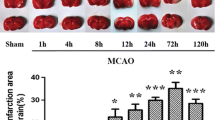Summary
We investigated the extravasation of serum albumin using immunohistochemistry in three different conditions, i.e., infarction, selective neuronal death and selective loss of presynaptic terminals following cerebral ischemia in gerbils. In selective neuronal death, which is typically found in the CA1 neurons of the hippocampus after 5-min bilateral cerebral ischemia, selective damage of postsynaptic components with intact presynaptic sites was demonstrated by immunohistochemical examination for microtubule-associated protein 2 and synapsin I, and albumin extravasation did not become apparent before postsynaptic structures were destroyed. In cerebral infarction, which was consistently observed in the thalamus after 15-min forebrain ischemia, massive albumin extravasation was visible early after ischemia due probably to the ischemic endothelial necrosis. In selective loss of presynaptic terminals, which was detected at the molecular layer of the dentate gyrus in the contralateral, nonischemic hippocampus after unilateral cerebral ischemia, immunoreaction for albumin was not visualized. Since endothelium and glial cells were intact in morphological aspects in selective damage of both pre- and postsynaptic sites, it was thought that extravasation was facilitated by the stimulation of endothelial cells and glial cells with unknown factors that were induced by the destruction of post- but not presynaptic elements.
Similar content being viewed by others
References
Chui E, Wilmes F, Sotelo JE, Horie R, Fujiwara K, Suzuki R, Klatzo J (1981) Immunocytochemical studies on extravasation of serum proteins in cerebrovascular disorders. In: Cervos-Navarro J, Fritschka E (eds) Cerebral microcirculation and metabolism. Raven Press, New York, pp 121–127
Dobbin J, Crockard HA, Ross-Russell R (1989) Transient blood-brain barrier permeability following profound temporary global ischaemia: an experimental study using 14C-AIB. J Cereb Blood Flow Metab 9:71–78
Fishman RA (1986) Brain edema. In: Barnett HJM, Mohr JP, Stein BM, Yatsu FM (eds) Stroke. Churchill Livingstone, New York, pp 119–126
Hirokawa N, Sobue K, Kanda K, Harada A, Yorifuji H (1989) The cytoskeletal architecture of the presynaptic terminals and molecular structure of synapsin I. J Cell Biol 108:111–126
Ito U, Go KG, Walker JT, Spatz JM, Klatzo I (1976) Experimental cerebral ischemia in mongolian gerbils. III. Behaviour of the blood-brain barrier. Acta Neuropathol (Berl) 34:1–6
Kirino T (1982) Delayed neuronal death in the gerbil hippocampus following ischemia. Brain Res 239:57–69
Kirino T, Sano K (1980) Changes in the contralateral dentate gyrus in mongolian gerbils subjected to unilateral cerebral ischemia. Acta Neuropathol (Berl) 50:121–129
Kirino T, Tamura A, Sano K (1990) Chronic maintenance of presynaptic terminals in gliotic hippocampus following ischemia. Brain Res 510:17–25
Kitagawa K, Matsumoto M, Handa N, Fukunaga R, Ueda H, Isaka Y, Kimura K, Kamada T (1989) Prediction of strokeprone gerbils and their cerebral circulation. Brain Res 479:263–269
Kitagawa K, Matsumoto M, Niinobe M, Mikoshiba K, Hata R, Ueda H, Handa N, Fukunaga R, Isaka Y, Kimura K, Kamada T (1989) Microtubule-associated protein 2 as a sensitive marker for cerebral ischemic damage — Immunohistochemical investigation of dendritic damage. Neuroscience 31:401–411
Kitagawa K, Matsumoto M, Tagaya M, Ueda H, Oku N, Kuwabara K, Ohtsuki T, Handa N, Kimura K, Kamada T (1991) Temporal profile of serum albumin extravasation following cerebral ischemia in a newly established reproducible gerbil model for vasogenic brain edema: a combined immunohistochemical and dye tracer analysis. Acta Neuropathol 82:164–171
Kitagawa K, Matsumoto M, Sobue K, Tagaya M, Okabe T, Niinobe M, Ohtsuki T, Handa N, Kimura K, Mikoshiba K, Kamada T (1992) The synapsin I brain distribution in ischemia. Neuroscience 46:287–299
Matsumoto M, Yamamoto K, Homburger HA, Yanagihara T (1987) Early detection of cerebral ischemic damage and repair process in the gerbil by use of an immunohistochemical technique. Mayo Clin Proc 62:460–472
Matsumoto M, Hatakeyama T, Akai F, Brengman JM, Yanagihara T (1988) Prediction of stroke before and after unilateral occlusion of the common carotid artery in gerbils. Stroke 19:490–497
Matsumoto M, Hatakeyama T, Morimoto K, Yanagihara T (1990) Cerebral blood flow and neuronal damage during progressive cerebral ischemia in gerbils. Stroke 21:1470–1477
Matsumoto M, Kitagawa K, Sobue K, Kuwabara K, Tagaya M, Ohtsuki T, Hata R, Handa N, Kimura K, Kamada T (1991) Selective damage of postsynaptic sides of neurons following ischemia causes delayed opening of blood-brain barrier, but that of presynaptic sides does not. J Cereb Blood Flow Metab 11 [Suppl 2]:S473
Niinobe M, Maeda N, Ino H, Mikoshiba K (1988) Characterization of microtubule-associated protein 2 from mouse brain and its localization in the cerebellar cortex. J Neurochem 51:1132–1139
Okabe T, Sobue K (1987) Identification of a new 84/82 kDa calmodulin-binding protein, which also interacts with actin filaments, tubulin and spectrin, as synapsin I. FEBS Lett 213:184–188
Petito CK, Pulsinelli WA, Jacobson G, Plum F (1982) Edema and vascular permeability in cerebral ischemia: comparison between ischemic neuronal damage and infarction. J Neuropathol Exp Neurol 41:423–436
Plum F (1983) What causes infarction in ischemic brain?: The Rombert Wartenberg Lecture. Neurology 33:222–233
Wolman M, Klatzo I, Chui E, Wilmes F, Nishimoto K, Fujiwara K, Spatz M (1981) Evaluation of the dye-protein tracers in pathophysiology of the blood-brain barrier. Acta Neuropathol (Berl) 54:55–61
Schmidt-Kastner R, Szymas J, Hossmann K-A (1990) Immunohistochemical study of glial reaction and serum-protein extravasation in relation to neuronal damage in rat hippocampus after ischemia. Neuroscience 38:527–540
Suzuki R, Yamaguchi T, Kirino T, Orzi F, Klatzo I (1983) The effects of 5-minute ischemia in Mongolian gerbils. 1. Blood-brain barrier, cerebral blood flow, and local cerebral glucose utilization changes. Acta Neuropathol (Berl) 60:207–216
Author information
Authors and Affiliations
Additional information
Supported in part by Research Grant for Cardiovascular Diseases (2A-2) from the Ministry of Health and Welfare and a Grant-in-aid (#03670450) from the Ministry of Education, Science and Culture, Japan
Rights and permissions
About this article
Cite this article
Kitagawa, K., Matsumoto, M., Ohtsuki, T. et al. The characteristics of blood-brain barrier in three different conditions — infarction, selective neuronal death and selective loss of presynaptic terminals — following cerebral ischemia. Acta Neuropathol 84, 378–386 (1992). https://doi.org/10.1007/BF00227664
Received:
Accepted:
Issue Date:
DOI: https://doi.org/10.1007/BF00227664




